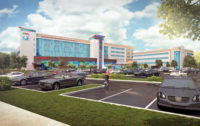For decades, there’s been talk of rail service connecting Baton Rouge and New Orleans, La. But now, after lobbying from the Southern Rail Commission (SRC) for a Gulf Coast regional rail coverage, this talk has begun to shift toward actual commitments.
Before leaving office, former Louisiana Gov. John Bel Edwards (D) signed Act 764, enabling the state’s Department of Transportation and Development to outline the scope, time, and budget to gain approval and secure permits to implement rail service between Baton Rouge and New Orleans. Now the state is moving forward with that exploratory work. With a focus on applying for grants and other funding sources, the Baton Rouge-New Orleans (BR-NOLA) Intercity Passenger Rail Feasibility Study was conducted to identify a path forward in implementing the project.
Before the service can be implemented, improvements must be completed. The track and structures making up the entire route must be upgraded to prepare for passenger car use. Rail crossing and signaling will additionally demand improvement. Bridges and culverts along the route must be assessed to measure integrity and initiate upgrades. In addition to reworking existing infrastructure, new stations and platforms will need to be constructed.
The total cost of the project has yet to be determined. Additional elements will include planning and environmental mitigation, and the rail service's operating costs still need to be identified.
According to the study, a 2010 assessment indicated that nearly $20 million in funding would be needed for mainline subgrade stabilization, embankment, and subgrade stabilization of siding extensions. Mainline bridge rehabilitation would monopolize the bulk of the expenditures at approximately $120 million and an additional $1.3 million to replace other structures.
Anticipating multiple improvement projects to prepare the existing railway, the recently completed study identified track, structures, and at-grade crossings as the primary infrastructure components needing attention. The current track structure includes mainline wood ties sized 7 in. by 9 in. by 8.5 in. and spaced at 19.5 in. on center. The corridor between Baton Rouge and New Orleans includes approximately 53 bridge structures, most of which consist of an open-deck layout on timbers, stringers, bents, and piers.
The route connecting Baton Rouge and New Orleans includes a segment of rail that crosses the Bonnet Carre Spillway, and prepping this segment would be a significant part of the project. Its existing 1.8 miles of 20-ft open-deck steel is not designed to support passenger rail.
According to the study, multiple aspects of the spillway’s rail crossing will require attention. Approximately 36% of the timber piles and 51% of the pier caps would need to be replaced. Dean Goodell, Freight and Rail Director with the LaDOTD, pointed to the need to replace the spillway’s existing rail crossing with a new concrete structure.
“This will be the largest of the improvements required,” said Goodell.
While the required permits are being evaluated, preparations are being made for the bid process. Beginning with one trip per day, the starting point and the schedule for initial service have yet to be determined.
"The initial service will start with one round trip daily during a trial period. At the end of that trial period, if everything is working correctly, a second-round trip per day will be introduced," said Goodell.
Before leaving office in early January, Edwards met with Amtrak's CEO Stephen Gardner and Louisiana’s Transportation Secretary Eric Kalivoda to sign an agreement and propel the project. The potential date for bringing the service online is projected to be 2027.
"The passenger train will provide a low-cost alternative to driving between cities along the route," said Goodell. "Businesspeople can continue to be productive with their cell phones and laptops while on the train.”



Post a comment to this article
Report Abusive Comment